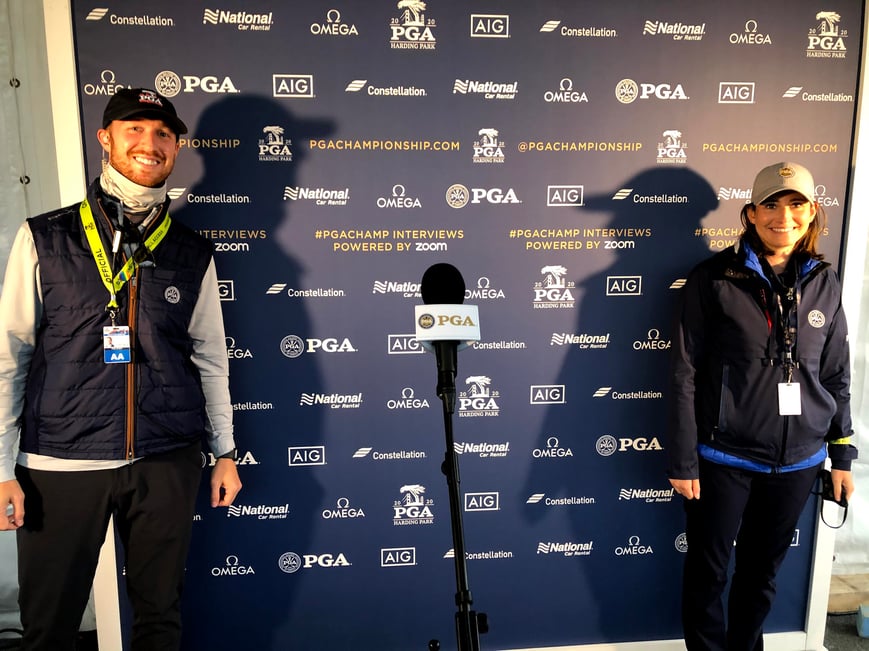Introduction
In March, the PGA of America needed to figure out how to help media members across the globe efficiently and effectively cover one of the largest sporting events of the year (the PGA Championship) "virtually".
Making sure each media member had access to any player, just as they would on-site, was a top priority in planning for coverage of this year's PGA Championship.
The Virtual Media Hub was born and the response has been incredible. The sentiment from everyone involved is that this is just the beginning of what will be done to support media on any type of event.
So even though a formal case study is helpful (see it here) I wanted to sit down with two of the individuals at the PGA of America that made this possible and get their honest perspective. Although there was a number of incredible folks and partners who worked on this project, I wanted to get both the media perspective and the tech/project management perspective.
Enjoy!
Guests
Patrick Kravitz
Media Relations Specialist, PGA of America
Liz Elliott
Championship Technology Manager, PGA of America
Watch
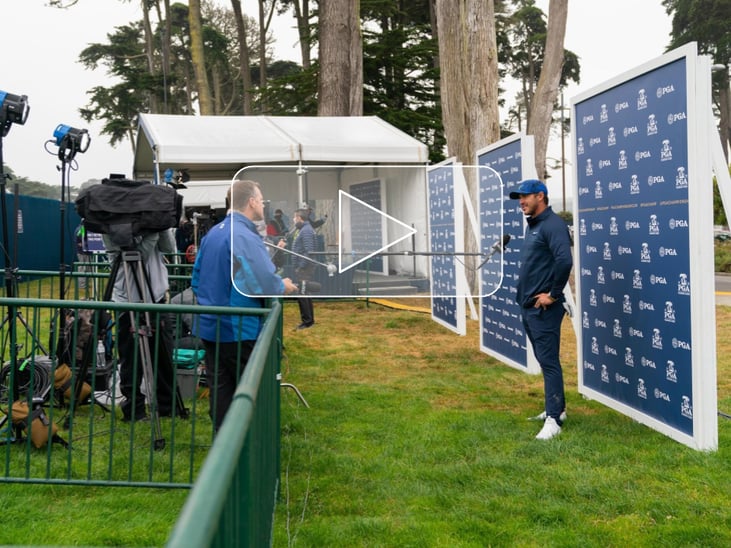
Listen
Jump ahead to
- What is the PGA? (0:49)
- Patrick and Liz's roles and responsibilities (4:04)
- Their key collaborators during COVID (10:47)
- A look at “normal” on-site operations (13:24)
- The most important thing they had to solve for in terms of media coverage (22:56)
- Getting buy-in for a virtual media center (29:37)
- Top goals and objectives for the media hub (31:34)
- How they used the media hub to vet, credential, and communicate efficiently (36:50)
- How they leveraged alerts and updates within the hub (43:43)
- How interviews, transcripts, and replays were managed through the media hub (46:22)
- Why even staff and support came to rely on the hub (55:24)
- The on-site set up (56:03)
- Their markers of success (1:04:16)
Notable Quotes
On learning from each other during uncertain times
"When we have a question about what others are doing, a lot of times we'll go out to our partner vendors and ask them, "What have you seen in the industry, what's your experience been?" So we can learn from them too." - Liz
On the equalizing aspects of remote work
"I think there's something equalizing about being all remote. There was much more of a feeling of that when everybody was working from home and dealing with things like kids who weren't able to be in school, and disruptions like normal everyday WiFi dropping. All of that kind of helps make us feel like we're in this together, we're gonna solve this problem together." - Liz
On the benefits of a virtual media hub
"The information that we were sharing through that news and alert section, it's not just for remote media, those that were on site used it as well, so it serves multiple purposes, it serves multiple groups, and I think that's why we're all so excited about how we can continue to enhance the experience both on-site and remote through the media hub." - Pat
On launching a new tool at an important event
My biggest fear was that there wouldn't be enough buy-in from media, just because it's a brand new tool and we've never used it before. They quickly squashed that fear; they used it immediately and enjoyed it." - Pat
On using Lennd’s Media Hub for future events
"We want to use this moving forward because it's a game changer, not just for media. It's also a game changer for our staff and for those that are invested in the media operation...This is a communications tool at its core." - Pat
Read the Transcript
0:00:01 Chris Carver: For those who are watching this, I just want to welcome you. I'm Chris Carver, co-founder and CEO of LENND, and this is a pretty special interview for me, especially since we just finished our first event with the PGA of America and I thought it'd be incredible to share what we did together. I definitely think it was really special because in a time like this, I think it's really important to share some of the nuances. And so, without further ado, I want to introduce Patrick Kravitz, the media relations specialist with the PGA of America and Liz Elliott, the Championship Technology Manager with the PGA of America. Welcome guys.
0:00:46 Patrick Kravitz: Thank you.
0:00:47 Liz Elliott: Thank you.
0:00:48 PK: Thanks, Chris.
0:00:49 CC: So before we dive into the meat of this, can one of you give me a brief explanation of who or what is the PGA of America for those who aren't diehard golf folks.
0:01:03 PK: Yeah, it's a question we receive all the time, and whenever we go to a new city with a championship or a new market for anything, we always try to describe who we are and our place in the golf industry.
At our core we're a member organization of 29,000 that's dedicated to advancing the sport in inclusion, advancing the sport in numbers, and really growing our game in so many different areas.
With that, we have a handful of championships that we manage. You mentioned the PGA Championship a couple weeks ago, that's our annual men's event that we run on the PGA Tour schedule. We have our KPMG Women's PGA Championship on the LPGA Tour schedule, the KitchenAid Senior PGA Championship on the PGA Tour Champions schedule, and every four years we run the Ryder Cup on the U.S. side, and we're involved whenever it's in Europe. At our core, however, we are that member organization of 29,000.
0:02:19 CC: That's awesome. And there's definitely a number of entities in professional golf, right? How does that fit within the other one, there's the PGA Tour, there's you guys, how does that all fit?
0:02:33 PK: There are so many organizations in golf with a lot of letters—PGA acronyms, the LPGA tour, Ladies European tour. It's a confusing industry. We are a separate organization from those folks, but I can tell you that we're very collaborative with those groups, especially over the last six months when we've all tried to figure this [COVID] thing out. We've been in constant communication really at every level, certainly in the media and PR space, it seems like we're on, if not weekly calls, every couple weeks, and I know our leadership has great relationships with the groups. while we are separate organizations, we certainly work with each other whenever we can, and certainly try to grow the sport together.
0:03:27 CC: Do you mind expanding on those roles and responsibilities for each of you?
0:04:07 LE: Sure. So I work within the technology department inside of PGA, we're a group of a couple of dozen folks who really support the enterprise productivity of the PGA Association, and then also help with innovative ideas to drive the association forward in terms of technology. So personally, I have a team of four talented engineers and product folks...
0:04:46 CC: I think we lost her. While she's figuring that out, why don't you jump into your role?
0:04:55 PK: Absolutely. We didn't experience this at the PGA Championship, thankfully. So my role is more focused on the championship side. I would say I would spend maybe 60% of my role preparing for those spectator championships that I mentioned, specifically on the media operation side, which means I'm basically the point person for any credentialed media member at those events as it relates to how they arrive, what type of access they receive.
I'm not on an island. I certainly have plenty of people, both at PGA of America that support me on that, as well as volunteers, vendors, other outside media operations professionals. But overall it's an exciting role and it's really kind of evolved even over the last several years.
0:06:16 CC: And how did you get into all this Patrick?
0:06:33 PK: My first internship in sports was in 2012 at the PGA Championship at Kiawah Island. I was in the middle of my undergrad at Ohio University studying sport management. So I always wanted to work in sports, but I never really identified which area. I kind of went in with no plans, which was kind of daunting in many ways.
0:07:09 PK: Yeah, it does. So, it was kind of a situation where my first role was in golf. And it kind of snowballed into a career and had a couple other internships after that. A trip out west to Chambers Bay for the US Open, where I worked for the United States Golf Association, another one of these large organizations in golf, and then ultimately made my way to South Florida towards the end of 2016. Welcome back, Liz.
0:07:43 LE: Internet issues. [chuckle]
0:07:47 CC: Hey, I hear you.
0:07:50 LE: Welcome to 2020.
0:07:50 CC: So Liz you're a part of a team of a couple dozen. That's a pretty big team.
0:07:58 LE: Yeah we've got a good technology team, a strong technology team. My personal team that I oversee and collaborate with, we work as consultants and also engineers, and build some of the solutions to solve problems for our internal stakeholders, but ultimately our customers who are spectators, staff, and support for championship, and then internal business operations for the championships themselves.
0:08:30 CC: And how did you get into the industry and what led you to this point?
0:08:41 LE: Sure. I'll try to make it a quick version, but I've been in the industry for about 20 years, so I'm a veteran. When I graduated high school, I went out to California to college and was an English major, and dropped out about a year and a half later and decided to move to New York City, and worked in the fashion styling industry as an office manager. The guy sitting behind me who was getting paid much more than me was an HTML developer. I guess we called them web producers back then. And I thought, "He's making so much more than me, that doesn't seem that hard." So I would turn my chair around and kind of watch what he was doing and learned that. So I became a web producer.
0:09:24 LE: Ultimately, I turned into an engineer or a web developer, and then transitioned to a technical project manager for a couple of years, more recently, and worked in a bunch of different industries, including banking, the fashion styling industry, and now in sports. So it's been a fun journey.
0:09:51 CC: And how long have you been with the PGA Liz?
0:09:54 LE: About three years.
0:09:55 CC: So Patrick, it sounds like you were pretty intentional about working in sports." Liz, you had this opportunity come up. What was that feeling like? What were you thinking at that point?
0:10:11 LE: Oh, at our last position, one of my colleagues, George Whittaker worked there. And we had gotten to know each other really well and worked together for a number of years at that business. And he moved over to the PGA and called me while I was doing my own thing, and I had opened my own business, a family business and was working as an entrepreneur and said, "Hey, I'd love for you to come over and join us at PGA." And at that point, it just felt like the right opportunity and the right place, the right location. So I said, yes.
0:10:47 CC: I'd love to hear a little bit more from both of you, how much are you collaborating with other organizations on best practices? Liz technology? And if you do, who do you find yourself collaborating with the most?
0:11:09 PK: Yeah, yeah. I mentioned a little bit on the front-end. We always connect with these other major stakeholders in golf, at least once a year, but I think more frequently, again over the last six months, and that includes the LPGA Tour, the Ladies European Tour, the PGA Tour, European tour, R&A, Augusta National, and the USGA. Those are the seven groups that we are in touch with frequently, and we're watching their events, trying to share best practices as much as we can because collectively when each of us are succeeding, golf can grow as a sport.
0:11:52 PK: Beyond that, our team connected with the NBA, Major League Baseball over the last six months to really understand how they were preparing for their return specifically, again with how they were going to manage the media operation. So it’s important for us to go beyond the sport of golf and really see what some of these other groups are doing. But those were the main conversations that we were having.
0:12:22 CC: And Liz from a technology standpoint, are you collaborating with other folks?
0:12:33 LE: Yeah, we definitely reach out to other contacts in the golf industry, but I think everybody on our technology team also brings along a wealth of contacts from other places, as Pat was saying. So generally, the event industry, there's a lot of overlap with what we do and what they do in terms of ticketing, credentialing, media, all that type of stuff, handling artists and contestants in a similar way.
0:13:01 LE: But we're pretty tight with our enterprise vendors too, so we have good relationships with Amazon and Google and LENND, for example. When we have a question about what others are doing, a lot of times we'll go out to our partner vendors and ask them, "What have you seen in the industry, what's your experience been?" So we can learn from them too.
0:13:24 CC: What historically goes into managing media on-site and how you execute it? I know there's a lot there, but for context it would be helpful.
0:13:50 PK: Yeah, traditionally, I would say we're starting our media planning for an event, maybe around 18 months out. We have a team of maybe three or four that are positioned at these championships, so Kiawah Island is the host of next year's PGA Championship. We've had a team out there for really the better part of the last year, year and a half, and they're starting to produce plans, site plans specifically as soon as they arrive on site, which includes, obviously, the media center.
In terms of my preparation for that space, it's working closely on the credentialing side. Now that we're partnered up with you and your team at LENND, it's really trying to hone in on how we can best provide the proper access to media. We have a good understanding of who from a national and international level should receive which type of access. On a local level, however, since we are a rotating championship and moving to new markets each year, we work closely with a PR agency in that specific market to better understand those relationships and the types of media that they have in that region.
So I think it's really trying to prepare for the media center credentialing, working closely with vendors to ensure that we have everything set up so that once people arrive on site, they can do their job with little to no help at all.
0:15:33 CC: Can you give me a visual of what this media footprint is like on-site, whether it's the media center or the number of media typically in a pre-COVID environment?
0:15:46 PK: I don't have the exact figure as it relates to how much square footage, but it's a pretty large facility, it has space for about 250 working press seats. There's a photographer's room with about 40 seats, which includes lockers. There's a giant interview room that can hold up to 200 people, it has a camera riser, we have about 20 radio booths, there's a large media dining area, and there's a giant video board that can show the broadcasts on multiple feeds, as well as the leaderboard, so it's an impressive space when you're on site, it is a place that we try and show to our partners, to future site personnel, because it is impressive once you're there, and the video board certainly stands out.
Overall, there are typically around 800 media that we've historically credentialed at the PGA Championship. I think one of the main challenges that our group is constantly facing is we have 800 people who all would love to have a seat, but we really only have space for about 250 of them, so that's definitely one of the main challenges—trying to maximize the space as best as we can.
2018 PGA Championship Media Center.jpg?width=6000&name=PGACHAMP_08_10_18_006_jpg_LargeImage_m78686%20(1).jpg)
2020 PGA Championship Media Center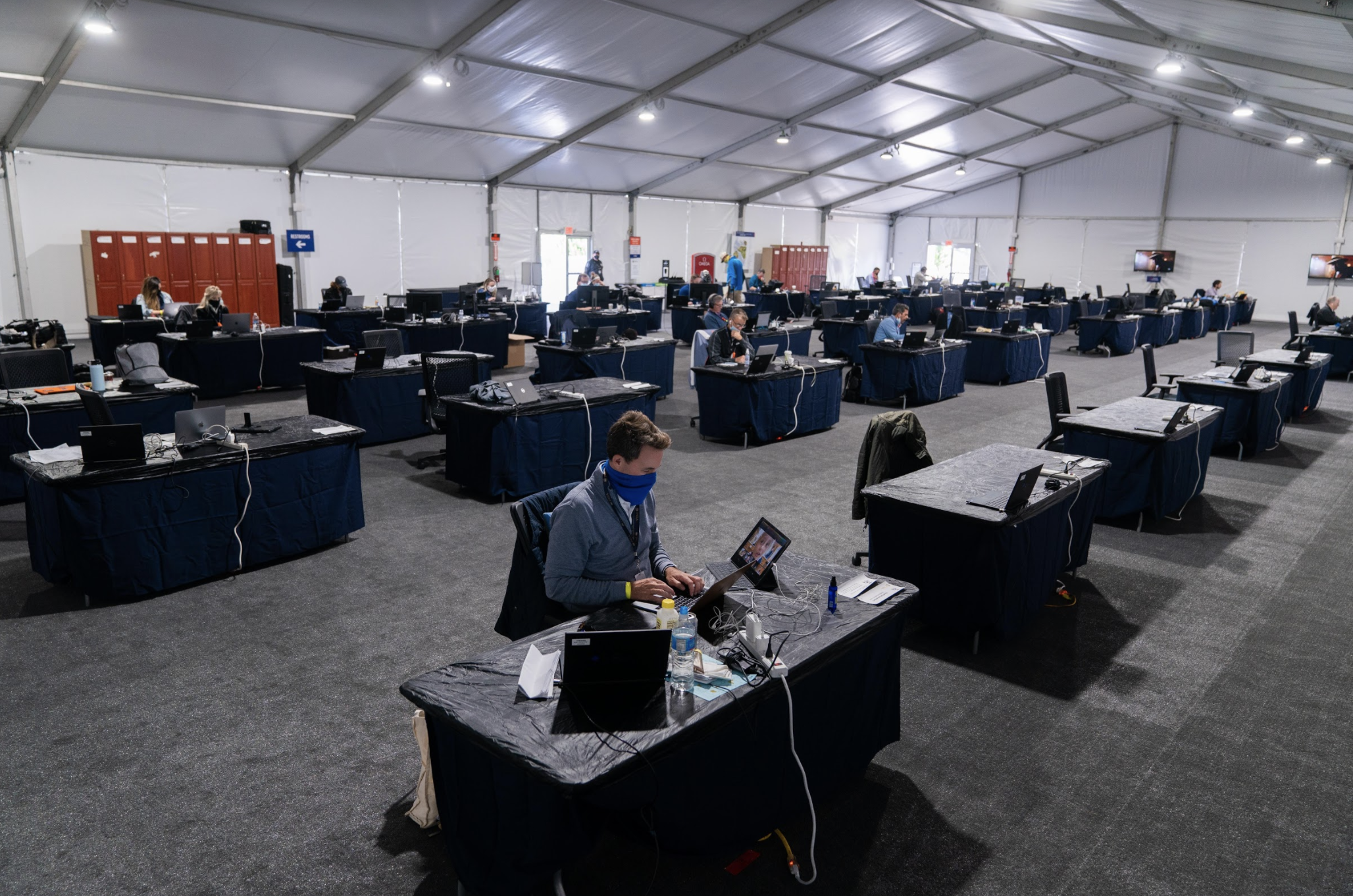
0:17:12 CC: Wow, and that's a temporary structure...
0:17:19 PK: Yeah, it's a full-on tent, they make it look really nice. Props to our ops team, and certainly all the vendors that we bring in. It's a comfortable facility, you certainly don't feel like you're in a tent, it's very professionally done when you're in there. There are instances at our KPMG Women's PGA championship, and the KitchenAid Senior PGA Championship where those typically have a little bit smaller footprint requirements. We are sometimes able to leverage permanent facilities, whether it's a clubhouse or some other building that's on site, but for the most part, we're working out of a tent for the better part of 10 days.
0:18:06 CC: What does the operational team look like to support that size on-site from vendors, contractors, and temp workers?
0:18:22 PK: We have, I wanna say maybe five or six PGA of America professionals working on the PR side that are on-site, usually around 40 to 50 volunteers, not at a time, but over the course of the week. If I had to guess maybe a dozen vendors that have some sort of reason to be in the media center and supporting those efforts.
The local PR agency that I mentioned earlier, they typically have a few people, and we have a group of maybe six to eight individuals that have travelled to the PGA Championship and worked for us in more of an official capacity that have experience on the media operation side; they have institutional knowledge of how our championship's run, and we can lean on them for the variety of tasks that come up, but it's a large team and everybody's working on different things, but we're all steering in the same direction.
0:19:26 CC: So take me back to March of this year, and walk me through what's going through your heads, both personally and as it pertains to your events.
0:19:48 LE: March. Wow it feels like a lifetime ago.
0:19:53 CC: It's COVID years.
0:19:55 LE: Yeah, obviously, obviously, there are a lot of question marks, both personally and professionally. We're lucky to live in Florida where we can go outside and be socially isolated and enjoy beautiful weather, so I think we have it a little bit better than potentially other people.
But yeah, as a company that relies heavily on the popularity and revenue from professional championship sports, it was a little bit scary, at least for us as employees to consider what impact that might have on our company. Pat, I'm sure you could speak to specifically the media center and what your thoughts were.
0:20:40 PK: Yeah, I went back and looked to see when our last date was in the office, it was March 13. And that's obviously, when everything came down across the world, but really in the sports industry, that's when things kind of shut down.
For me professionally, we had just launched our credentialing for the PGA Championship, like a week or two weeks before that. So I'm trying to process in real time, "Okay, what does this mean for the PGA Championship which was scheduled to be played in mid-May?" (two months later).
Those were the questions that I was asking; how is this going to impact our events? And certainly, I think everybody, to some degree, was asking that and trying to prepare for what could become a rescheduled date or a cancellation or whatever the case was, but like Liz said there was a lot of uncertainty.
0:21:45 CC: How would you describe the challenges you were faced with when it came to media covering the PGA Championship?
0:22:14 PK: So even before we knew that we were moving the championship from May to August, we started meeting internally, originally, John Dever, my boss, he's the director of PR for championships, we had a meeting that morning of March 13 and started laying out scenarios of, "Are we gonna have a full media center with 800 media? Are we gonna have half of that? Are we gonna have a handful? Are we gonna have no media?" These were the kind of questions and scenarios that we were throwing out there and playing with.
0:22:56 PK: The most important thing, I think to us, when trying to solve for this new situation, was to make sure the media would be able to have player access. It didn't necessarily mean that they had to be on-site, and we obviously learned, which we'll get into, that media can have access to players even if they're remote.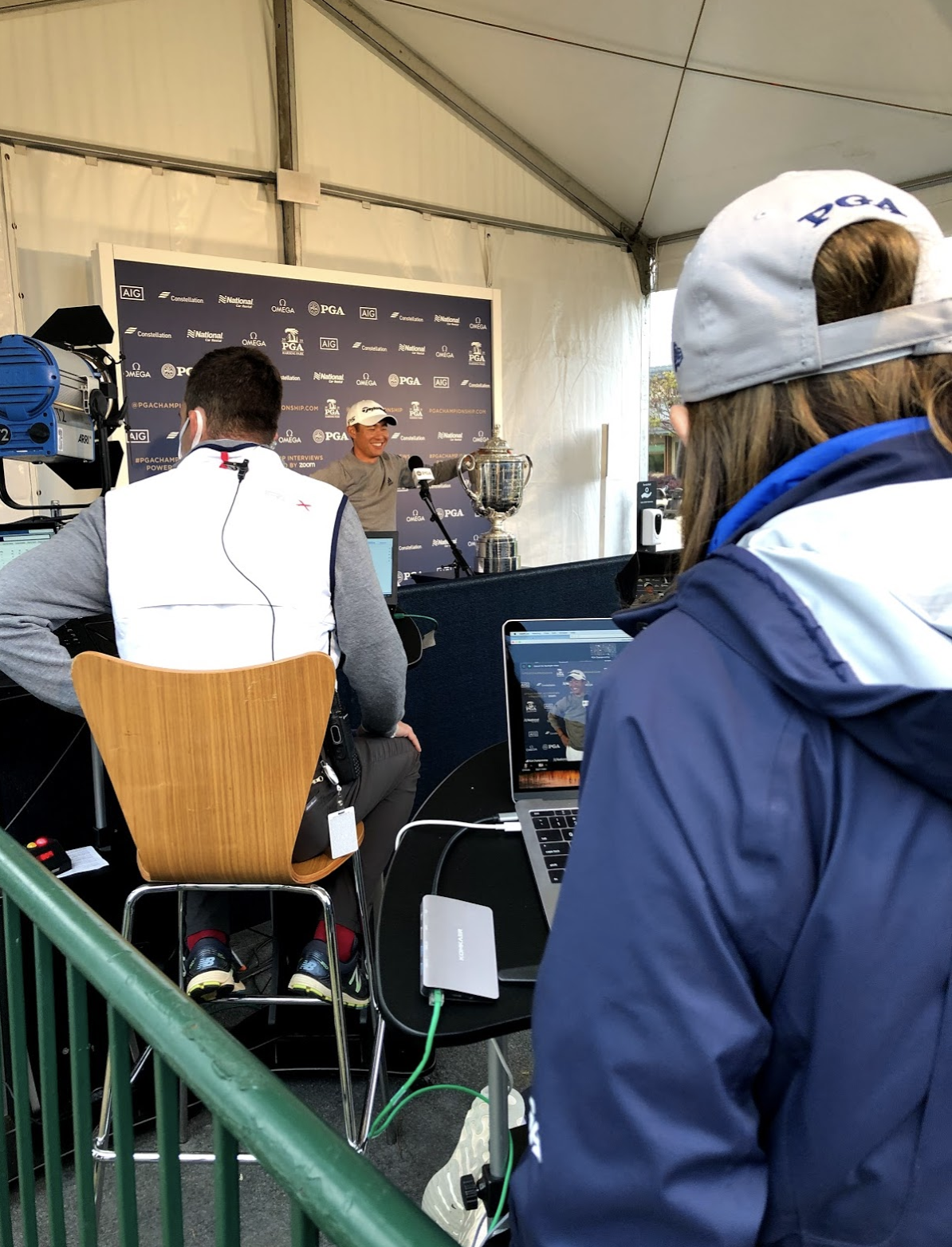
But I think one of the situations I was following early on was how the media were interacting with players. Not necessarily in golf, because golf had shut down at that point, but the NFL draft was one of the first major virtual events in sports really across any industry but that was one that I think everybody was paying attention to.
0:23:45 PK: I remember reading an interview with Sal Paolantonio of ESPN, and he spoke of the importance of being able to talk to a player and have that dialogue directly with the player. I know there's this...idea that “I'm gonna be there with the player, so I can receive your question and then read it on your behalf and we can get the answer and transcribe it and send it to you." But that's not really valuable to the media, they wanna be able to hear the player, they wanna be able to see the player, they wanna be able to ask follow-up questions if they need to. They wanna ask the question in their own voice. So it was really trying to understand how we could do that in a way that I think the media would grasp onto.
0:24:38 CC: At what point in time is this where you're saying, "Okay, we need to figure this out?"
0:24:53 PK: We had a good feeling things were gonna move, but we didn't know for sure until April. The tour announced on April 17 that our championship along with several of their events were moving to new dates. So I would say maybe a week or two weeks before that announcement, we had a really good understanding of, "Okay, this is happening." We knew the championship was moving to August, but at that point we didn't announce a spectator-less championship. But our whole media announcement of having limited media on-site was really predicated on that spectator aspect. But yeah, I think early April is when things started to get a little bit more real.
0:25:48 CC: Obviously you guys collaborated, two different departments, what are the discussions like at that point, internally?
0:26:09 PK: Yeah, I think Liz you can speak probably better to this than I can. But it was such a unique period because we had just started working from home and traditionally we're in an office, so everybody's starting to learn these new tools that we have available to us to help that.
0:26:28 PK: From having everybody learning how to do video conference meetings and sharing screens and learning that process while also trying to balance the [job itself]. We have a major event that we need to figure out...how our roles are going to have to evolve. It was a very complicated time, but I think everybody rose to the occasion, and from my perspective, I don't think the collaboration had ever been better.
I would say that for Liz and I, we certainly had a relationship in the office of working on projects, but to the degree that we've been working together the last six months, it felt like every two hours we were on some sort of a call. So collaboration was kind of at this utmost priority, and I think everybody appreciated that.
0:27:30 CC: Yeah, Liz, I definitely don't wanna underplay the role of technology because it's a significant size in PGA. It seems like it was something that they wanted to invest in a while ago, but I feel like at a time like this, that your department just becomes that much more important.
0:27:54 LE: Yeah, and I think, while Pat was rightly fixated on what the media were expecting in terms of access to the players and how they were gonna accomplish that, and watching the NFL Draft and just kind of seeing how that all played out, from the technology side, we were analyzing, "Well, how did they actually accomplish it using technology?"
Reading articles, doing research, reaching out to contacts and finding out, "Well, what was the infrastructure like and did they send everybody a little AV package, and who was in their house, and what happens if somebody started playing a video game and messed with their network, the strength?"
So yeah, I think we both came at it from different angles, and ultimately that's the strength of collaborating, coming from different places, understanding what the needs are, and working together.
0:28:50 LE: I think the other thing is that we're all working remotely, all of our video feeds are the same size, and there's something equalizing about being all remote, we're all in the same boat. In some ways, we're all in this together; there was much more of a feeling of that when everybody was working from home and dealing with things like kids who weren't able to be in school, and disruptions like normal everyday WiFi dropping. All of that kind of helps make us feel like we're in this together, we're gonna solve this problem together, we'll all come at it from different angles, and we'll all respect each other, and find the right solution together.
0:29:32 CC: That's awesome.
0:29:32 LE: A good change. A good evolution, I think for the PGA, generally.
0:29:37 CC: It will be so interesting to see how these organizations, even one as old as the PGA, will end up evolving in terms of the way you work. I'm sure there are going to be some things that stick even when things go back.
So who were some of the key stakeholders in really pushing this through? Was everybody on board with this, or how did you guys start to organize yourselves?
0:30:08 PK: Every single department had some sort of influence on this project, I would say from obviously a media PR side, we had full support across our department, our Chief Commercial Officer bought in almost immediately. Those on the championships department side, their buy-in was immediate, and I think to me, that was very helpful, not necessarily having to sell this idea, but more so having enough time to be like, "Okay, we need to solve for these 25 issues." And having the support of everybody behind us was critical, and I'm sure Liz can speak to the technology team support as well. That was certainly critical.
0:31:00 LE: Yeah, at least with us, it was very important that we had buy-in from the directors, the senior director, and the CFO who we report to, so keeping that whole team in the loop, making sure that everybody was comfortable with the Zoom solution, for example. And then looking at what tools we already have an enterprise relationship with that we could leverage here as opposed to going outside to someone new who we don't necessarily have that relationship with, so lots of people. Lots of collaboration.
0:31:34 CC: When you think about your goals and objectives, what would you say were the top goals and objectives in trying to implement something like a virtual media hub?
0:31:54 LE: Obviously the player access, player interviews was one of our top priorities, but above that was the communication level—making sure that our tools allowed both ourselves to communicate effectively, but also for the media to be able to take in that information in a way that was seamless. I think one of the unique things about our organization and the championships that we run, we typically only see these folks once a year, maybe twice a year, so a lot of our relationships are virtual in the sense of we're communicating with them through email, we're not the PGA Tour, where they have week-to-week events, they see these folks often. So we have experience with these relationships being virtual, and that certainly helped. We understand that we have one big opportunity each year to showcase ourselves in the best light and ultimately create a helpful opportunity for them to succeed in their roles.
.jpg?width=2241&name=PGAC_08_04_20_174_jpg_LargeImage_m192718%20(3).jpg)
0:33:06 PK: And communication is obviously that number one priority. So we were able to work closely with your team in identifying how we could most effectively do that through notifications, through a news and alerts kind of bulletin board. And I'm sure we're going to get to some of these aspects of the media hub, but the communication was so important for this project.
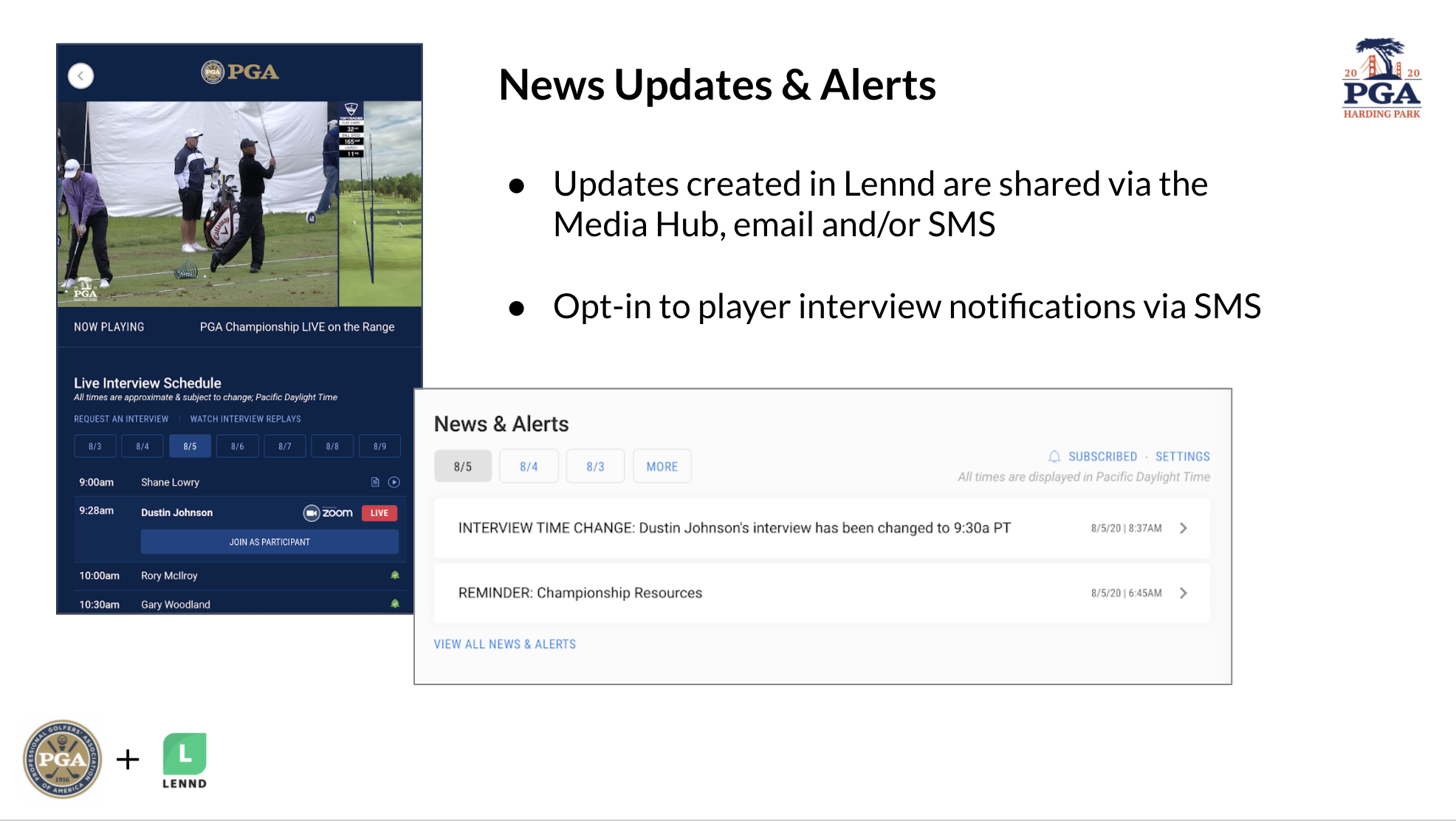
0:33:34 CC: This might sound like a loaded question, a naive question, but there are still people that are doing it this way. So I have to ask, why not just spin up a video conference, like a Zoom, or a WebEx, and just do your interviews that way? Why not just do that?
0:33:58 PK: No, it's a good question. There’s still value in having a face-to-face dialogue. I think there is a convenience factor. We learned through the course of the week that even those who were on-site, they became more comfortable with using our video conferencing tool; we use Zoom. They became very comfortable by the end of the week of just calling in from the media center, because maybe they only had one question and it wasn't necessarily worth the 30-minute walk it would have been to and from this area.
0:34:36 PK: So I think there's going to be a nice balance moving forward. It doesn't mean that we won't have people on-site. It doesn't mean we won't have a remote operation. I think there's value in both.
Media budgets are kind of all over the place right now. And we've seen the kind of impact that the pandemic has had on those who are in the media space. We're trying to adapt the best that we can to make sure that if somebody can't afford to travel, or if an outlet doesn't want to send somebody or it doesn't want to send multiple people, we can create opportunities for them to still have a very similar experience.
0:35:16 PK: We know it's not the same, but we want to replicate that experience the best way that we can.
0:35:22 LE: So the media hub becomes like a one-stop shop or a portal, where they're getting some of the same experiences they would on-site, they're getting messages directly from media specialists that are really only for the media audience. They're not getting just what every other kind of normal spectator is getting. They're still getting that insider's view with the media hub. They had direct access, support access to media specialists. They had a schedule that they could watch kind of in real time. So there were a lot of advantages to giving them a one-stop shop that only they were approved to see that gave them links to all of the resources that they needed to be able to do their jobs throughout the championship.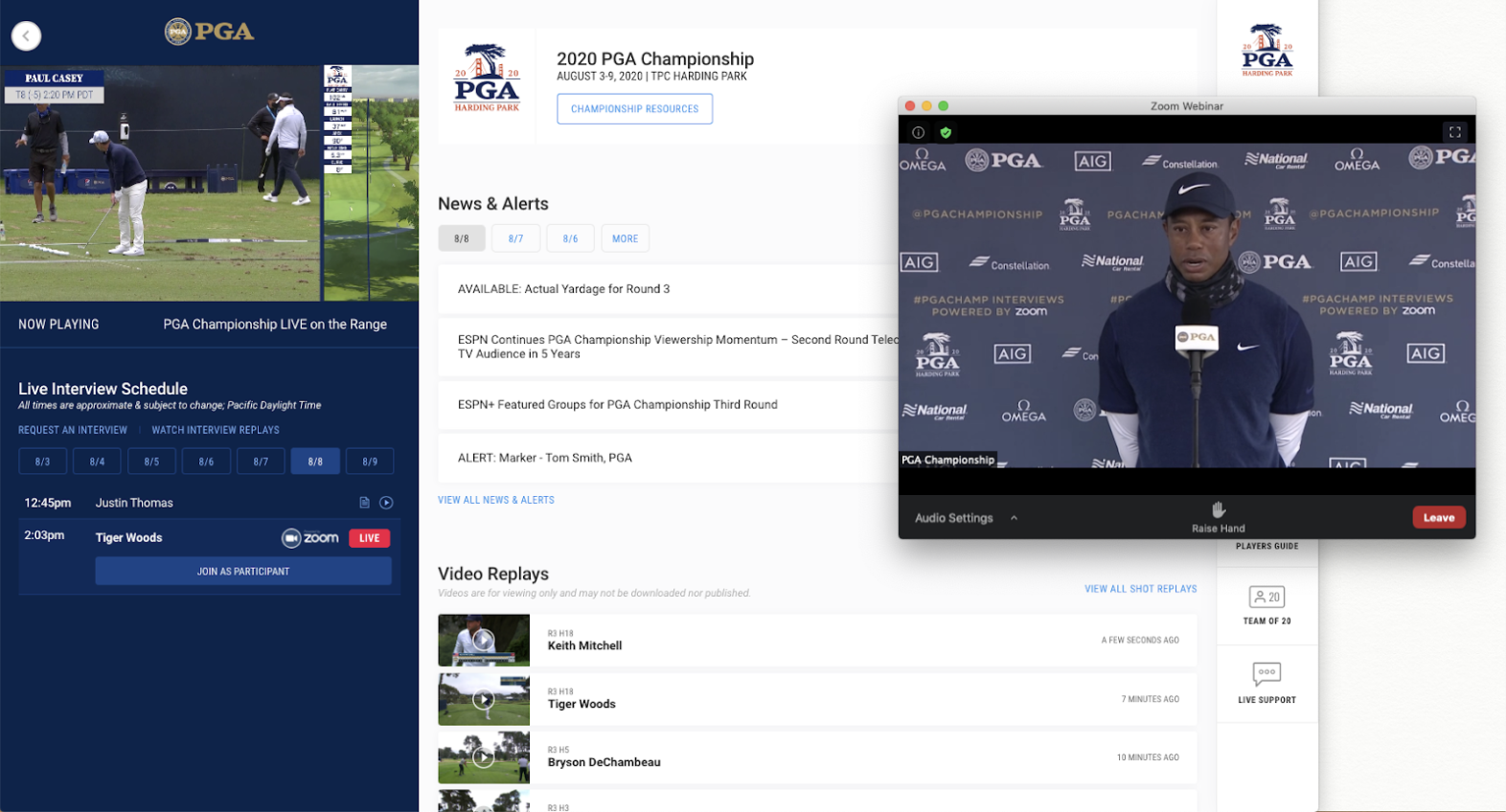
0:36:08 CC: Interesting. Yeah. So if you don't mind, I want to walk through the process of managing media now virtually. So maybe this is not the first step. I think it's the first step but as far as I know, the first step was to collect applications, right? Allow people to apply to cover the event...
0:36:36 PK: Yes, yeah, that's step one. And that's step one whether they were covering it through the media hub only or whether they were one of the select few that had on-site access.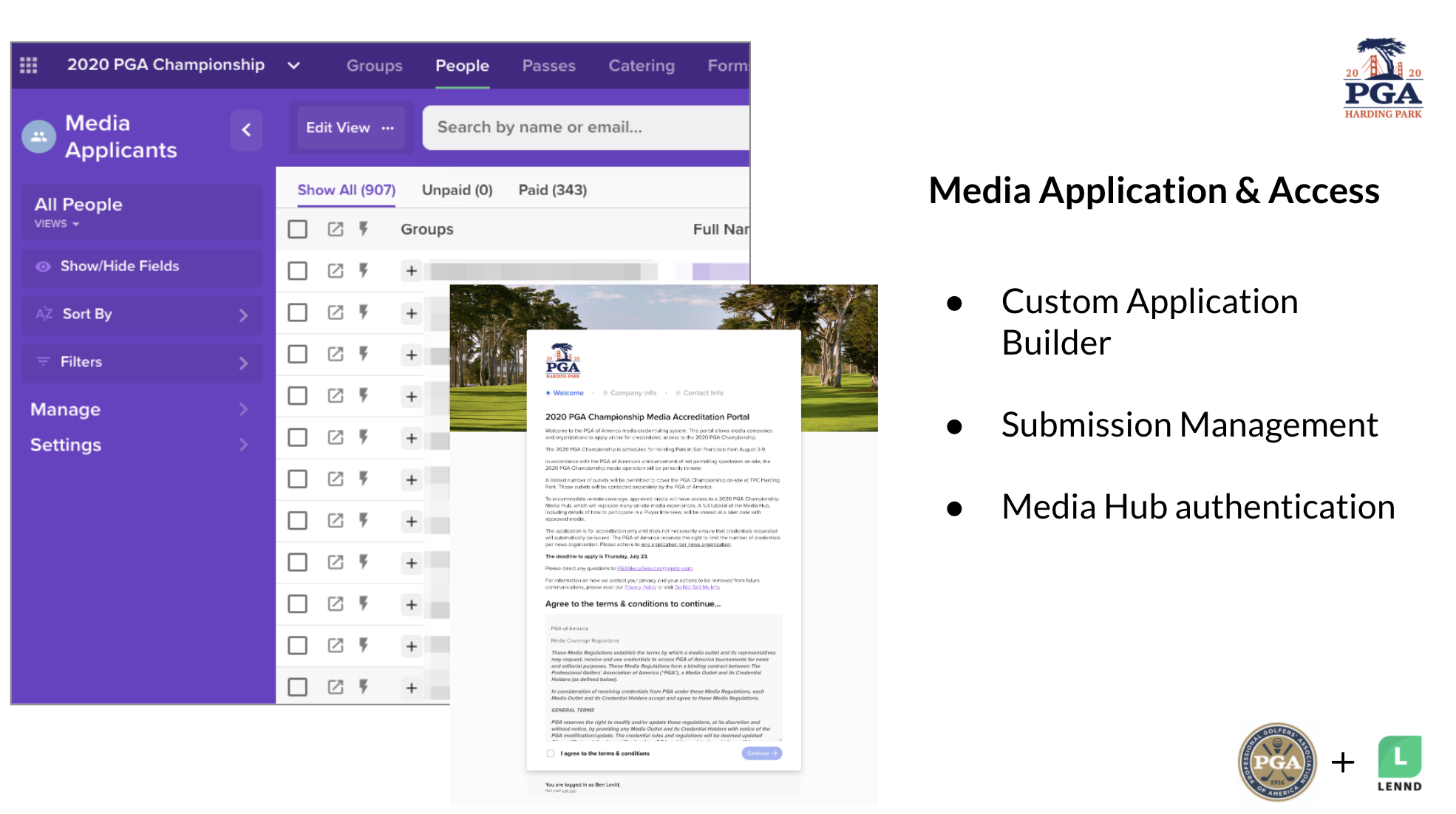
0:36:50 CC: And you obviously wanted the tool to be able to vet those media that you may not know, but you also had a pool of media that you do know. What's the next step in that process once they're vetted?
0:37:09 PK: Specifically to the media hub, word started to spread a little bit through some proactive outreach via either our PR agency or a couple of people working on our behalf, to make sure that people knew this was available to them. So there were probably more applications that I was unfamiliar with this year than previous years, just because there are these brand new audiences from all over the world that have access to this.
0:37:52 PK: So there was a lot of, "Hey, I don't necessarily recognize this outlet, did you push them our way?" And obviously working closely with the folks doing that outreach, as long as they were the folks who were directing these outlets our way there was a trust factor there. But we have a PR agency that does a lot of research on outlets and to make sure that they should have this level of access. But once they're approved, we kind of just go through the online line portal and send them an invitation to join the hub. It's a pretty quick process, maybe 30 seconds at the most.
0:38:36 CC: It was pretty important for you guys to connect it to your credentialing process. Why was that the case?
0:38:56 PK: It was just seamless really for us. And there's an advantage on the media side too of not having to do multiple applications. But for us to just have everything in one place was so convenient. You know, anybody who works in events knows how hectic an event week can be. So the more that you can do to set up these seamless experiences as an administrator, it really helps. And in this scenario, having everything in one place so that we could credential people through the media hub that week in a way that allowed them to experience the championship. It was just really helpful to have it all kind of right there.
0:39:46 CC: Why is that important to media to access a real-time schedule of press conferences and interviews as they came up, whether it's virtually or on-site?
0:40:20 PK: Yeah, I think on the player interview schedule specifically, for those that don't necessarily follow golf, the process as a player finishes their round, they go into a scoring tent to sign their scorecard. And if they're requested for interviews, that's typically as soon as they leave that scoring area, that's when a PR professional from whichever organization will kind of escort them through those stops. Whether it's just one stop at the media hub area, or if our broadcast partners ESPN, CBS, SiriusXM, Sky Sports, Golf Channel, if they all request them, we push them through that process.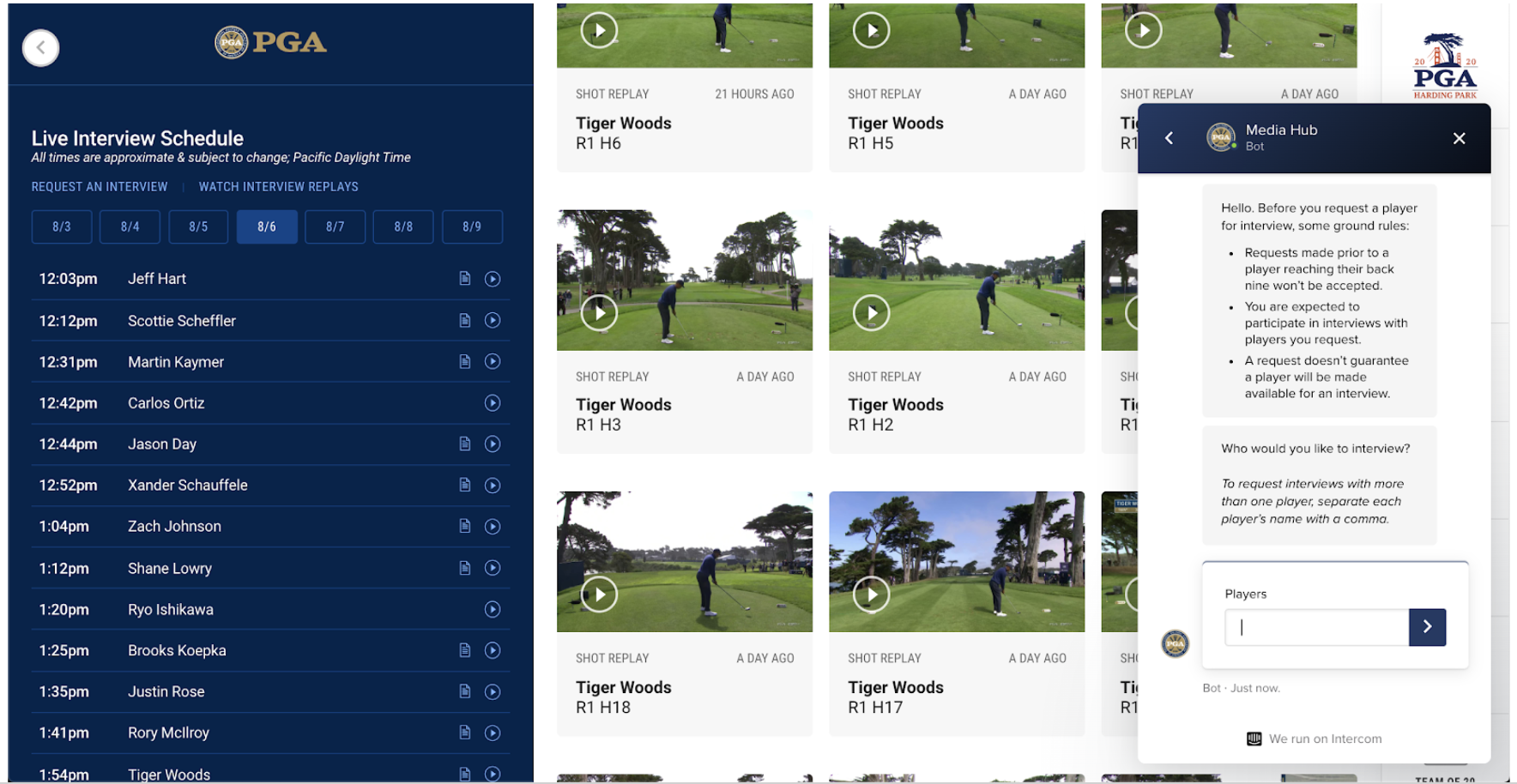
0:41:09 PK: I think the issue or one of the challenges I should say of communicating that virtually is that if a player is requested for multiple stops, it's kinda difficult to really understand, "Okay, when are they actually gonna be on the Zoom call?" So we had a person helping our team in an extraordinary way from Louisville, and we set her up with feeds. Liz can talk about all of her setup, but she was basically responsible for adding players to the schedule based on the requests that we were receiving, again through the media hub, and estimating when that player might actually be in that Zoom call.
0:41:57 PK: And for the most part, it was generally very accurate. Once she put that player on the schedule, it was up to me being on-site and seeing these things kind of unfolding in real-time, making the proper tweaks to the schedule. Seeing that Tiger Woods is gonna be requested by ESPN, then he's gonna do a stop with Golf Channel, then he's gonna do a SiriusXM Stop, what time does he actually make his way to the Zoom call? So there are a lot of moving pieces once you arrive on site. And it's kind of difficult to plan for that component because every player is kind of unique in how long they speak to media. But we were fortunate to have a lot of people supporting us both on-site and remotely.
0:42:45 LE: Yeah, golf is unique in that. From one hour to the next, it could change. So somebody can have a hole in one, somebody could have a great round, somebody could totally fall down. And those are the people that all of a sudden show up as a request through the media hub that maybe would have been totally unexpected.
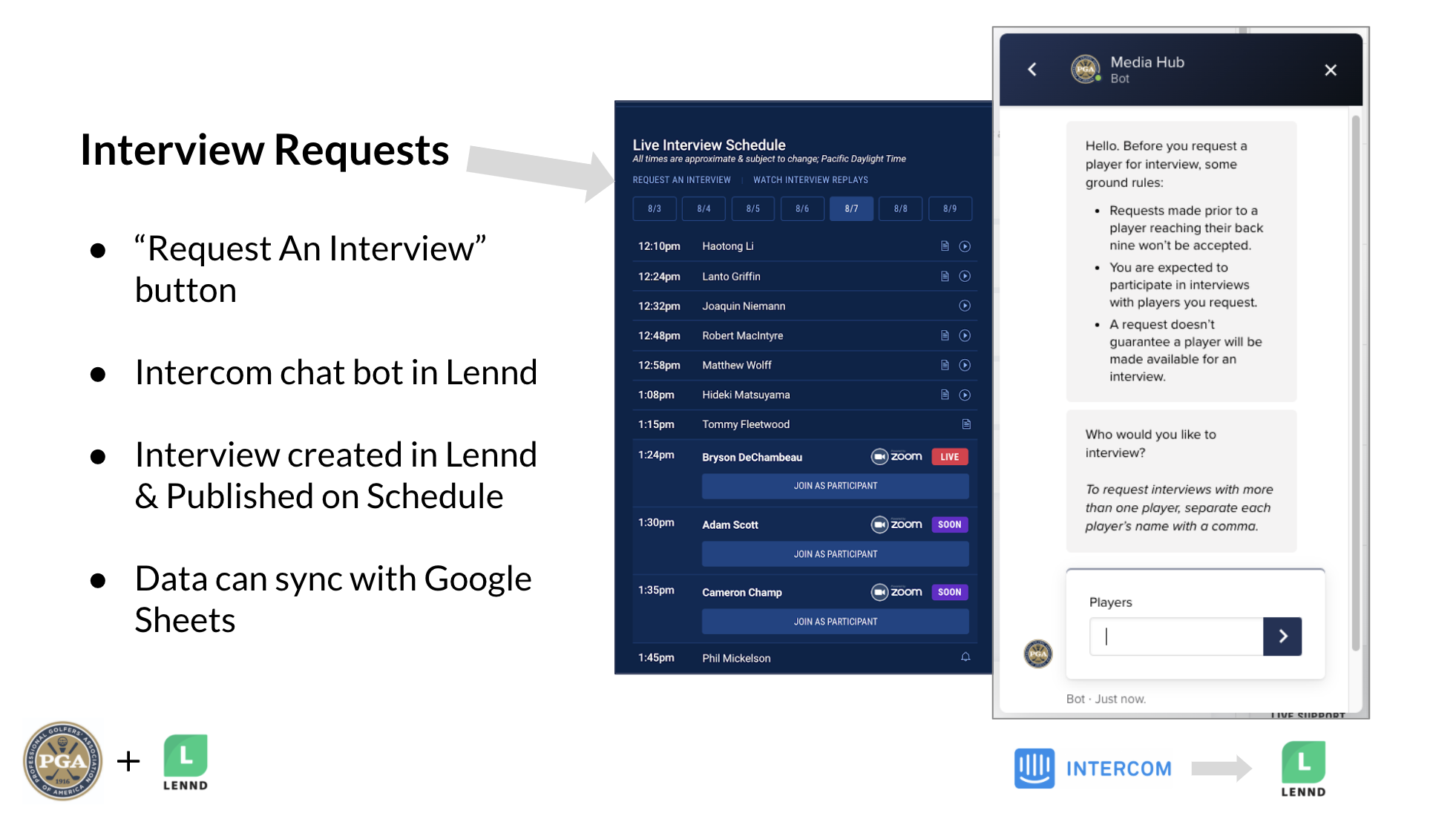
There's no way to plan for that from the staff and support side. So being able to really control the schedule in real-time was super important, because in real-time that schedule is changing. And so for us to be able to just have it and post it and the media could kinda keep their eyes on it not only in person but remotely and in the media center and see people's names shift and times change and see people's names added. That was really important to keep them in the loop of what was going on and whether or not their request was being granted for a particular player.
0:43:43 CC: Did you guys leverage alerts in that regard? Or how did you communicate out to people?
0:43:55 PK: Yeah, through the media hub we had SMS notifications. So if a media member was interested in a particular player or a particular interview, they had the option to receive notifications straight to their phone. If there were any significant changes to those times, most of the time it was, "Okay, we had this player scheduled for 1 o'clock and it looks like it's closer to 1:10.” So you just kinda push them back. But if it was significant, "Hey, this player was scheduled at 1 o'clock, but now it's gonna be 4 o'clock." That's something that we kind of pushed out as an alert via email, via text to keep that communication flowing as best that we could.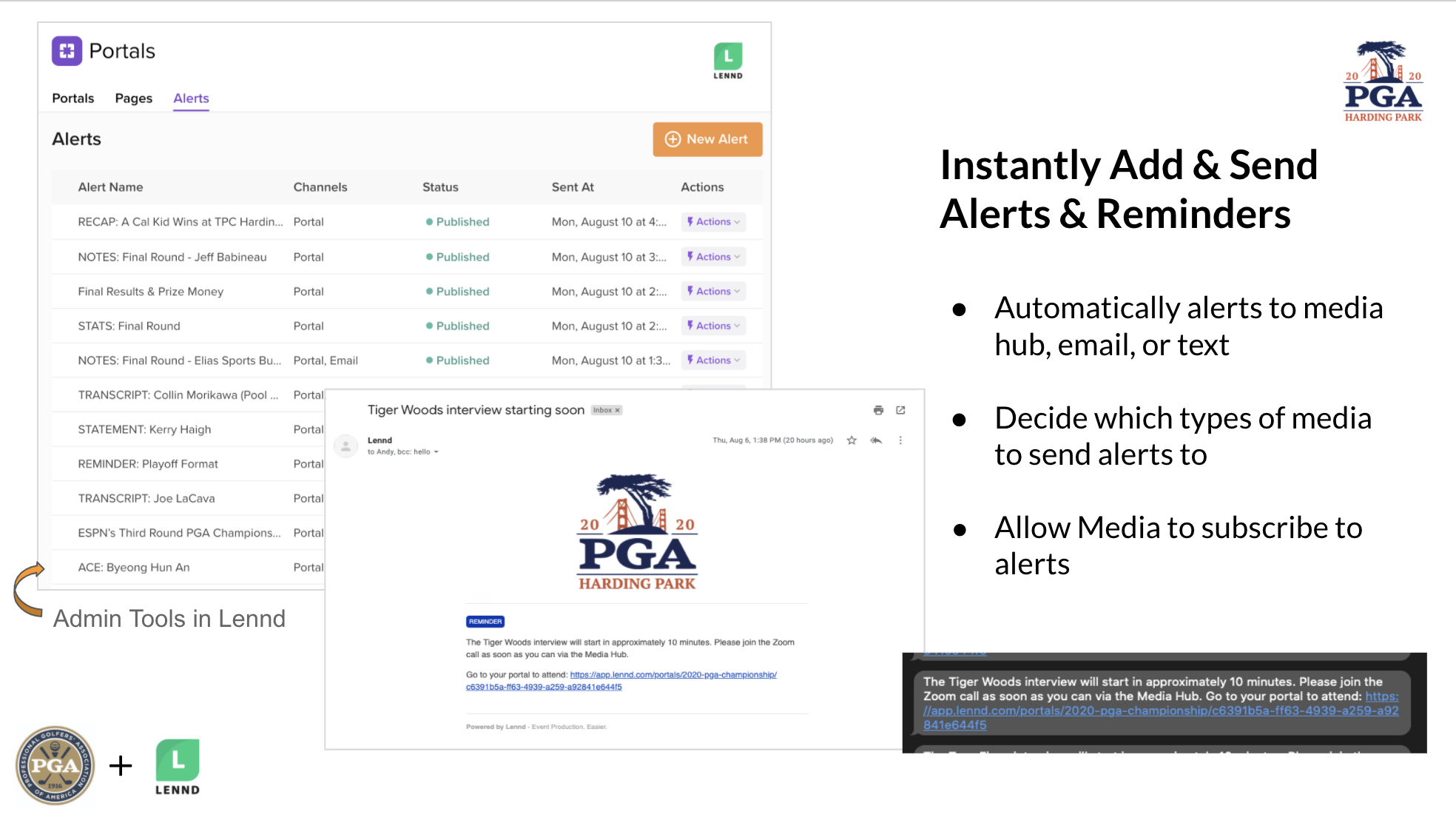
0:44:44 CC: And what else did you use the alerts for? I remember seeing a handful of different things. But from your perspective, what were those and why are they important?
0:44:57 PK: So for the news and alerts section of the media hub, we pushed 99 different pieces of information. And the types of information really varied. We had a lot of different field updates early in the week, we had some players deciding to withdraw from the field. So providing those, "Okay, who are the new players that are actually in the field now?" Being able to provide that in real-time was helpful.
There were also two different rulings that happened on the golf course that we were able to push an alert on through that system.
0:45:36 CC: What's a ruling?
0:45:37 PK: A ruling is if a player breaks a rule on the golf course...
0:45:41 CC: Oh, okay.
0:45:43 PK: What stroke penalty they incurred, why...
0:45:47 CC: Something media should know.
0:45:49 PK: Yes, exactly. If a ruling takes place, we get an email internally stating what happened. And at that point we're able to push it forward out to media. We send a variety of these news and alerts, a lot of different resources, hole locations, pairings, notes packages, so it was just a kind of a one-stop-shop for any sort of real-time information that was happening.
0:46:22 CC: And one of the things I noticed is, although you had a ton of interviews with players, you also had other interviews. How do you think that went off and, now after the fact, how are you thinking about those things?
0:46:43 PK: Yeah, we do have a handful of interviews that happen beyond the players, and it's typically earlier in the week. We annually have a PGA Championship news conference that features our organization's president, CEO, and chief championships officer. I think the unique part of that press conference is that it normally happens at a table. They're seated next to each other. We obviously did not have that option this year. So Liz can probably speak better to the logistics behind that, but that was an interesting process that we had to solve for.
0:47:26 LE: A fun process. Yeah, we [chuckle] scattered folks around the golf course, it was interesting, it was great. But I think also along the course of the championship week, there were other folks that had interesting roles that warranted interviews, including the marker who played a round early on. And even Pat and I looked at each other during championship rounds and said, "Who else can we get here?"
Because it's just interesting to interview people, it was so easy and seamless. And we did have a lot of interest, even over Zoom of folks attending those interviews that weren't players. So I think it's a lesson learned for us that there's an opportunity there to get the general manager of Harding Park to speak and some other folks who work behind the scenes that have interesting stories to tell too.
.jpg?width=2241&name=PGAC_08_04_20_194_jpg_LargeImage_m192723%20(3).jpg)
0:48:32 CC: Yeah, I think there was one early in the week with the CBS crew. I think it was the CBS crew. And it was just fascinating to see how they're prepping for the broadcast. I actually thought it was pretty entertaining, to say the least. One of the components of the media hub was being able to access transcripts. Again, this may seem obvious, but why was that important and why is it important to have it so fast?
0:49:03 PK: Yeah, it's kind of this expectation once an interview's finished that the transcript will be ready within 10 minutes. And the reason is, especially nowadays where news is really 24/7, having access to what a player said and being able to either post it on social media, if you're, again a media member, or if you're posting a story in the middle of the day, just being able to pull those clips out as quickly as possible is so critical.
And it allows the championship to be covered in a way that's dynamic. The team at ASAP Sports is the group that we use for transcription, and I think they enjoyed the week. They're typically on-site with us. This was one of the first years, perhaps the first year that they were not on-site at a PGA Championship. And from my understanding, they just kind of hung out at their house and stayed in the Zoom room. And they were pushing things out quicker than I've ever seen before. So transcripts, it's a necessity. And obviously, we use them, media use them pretty much all day.
0:50:22 CC: I'm curious how this was received, to be able to preview a recording or, yeah, review a recording of each interview after the fact.
0:50:36 PK: We worked with a company, Imagen that houses a lot of digital media assets, including our photo albums, complementary photos that we made available, as well as all of these interview press conferences, so that they could be used by affiliates in their nightly newscasts. That media had the option to download those clips to use select portions for their coverage. So being able to use it in their coverage was helpful, but also for us to go back and watch and I'm sure media to go back and watch and see how a player said something, it was nice to have that option. And again, very similar to transcripts, those video links were available within a few minutes of a press conference ending.
0:51:36 CC: Another component that I'd love to hear your thoughts on is you gave access to a real-time feed of scoring shots with the ability to search it by player. Why is that important? And walk me through why you guys wanted to have that in there.
0:51:56 PK: Yeah, so we worked with WSC Sports, who automatically generates these clips of anything that makes it to a broadcast, any shot that makes it to a broadcast. So anything that was on ESPN or CBS would automatically pull a clip and generate whatever, 30-second to minute-long video, and publish it to the media hub to allow media again, to kind of go back and watch and see how a player approached a certain shot or watch a big moment. I've gone back and watched Collin Morikawa's eagle on number 16 probably 15 times in the past week. So it really kind of lets you go back on demand and watch these things unfold.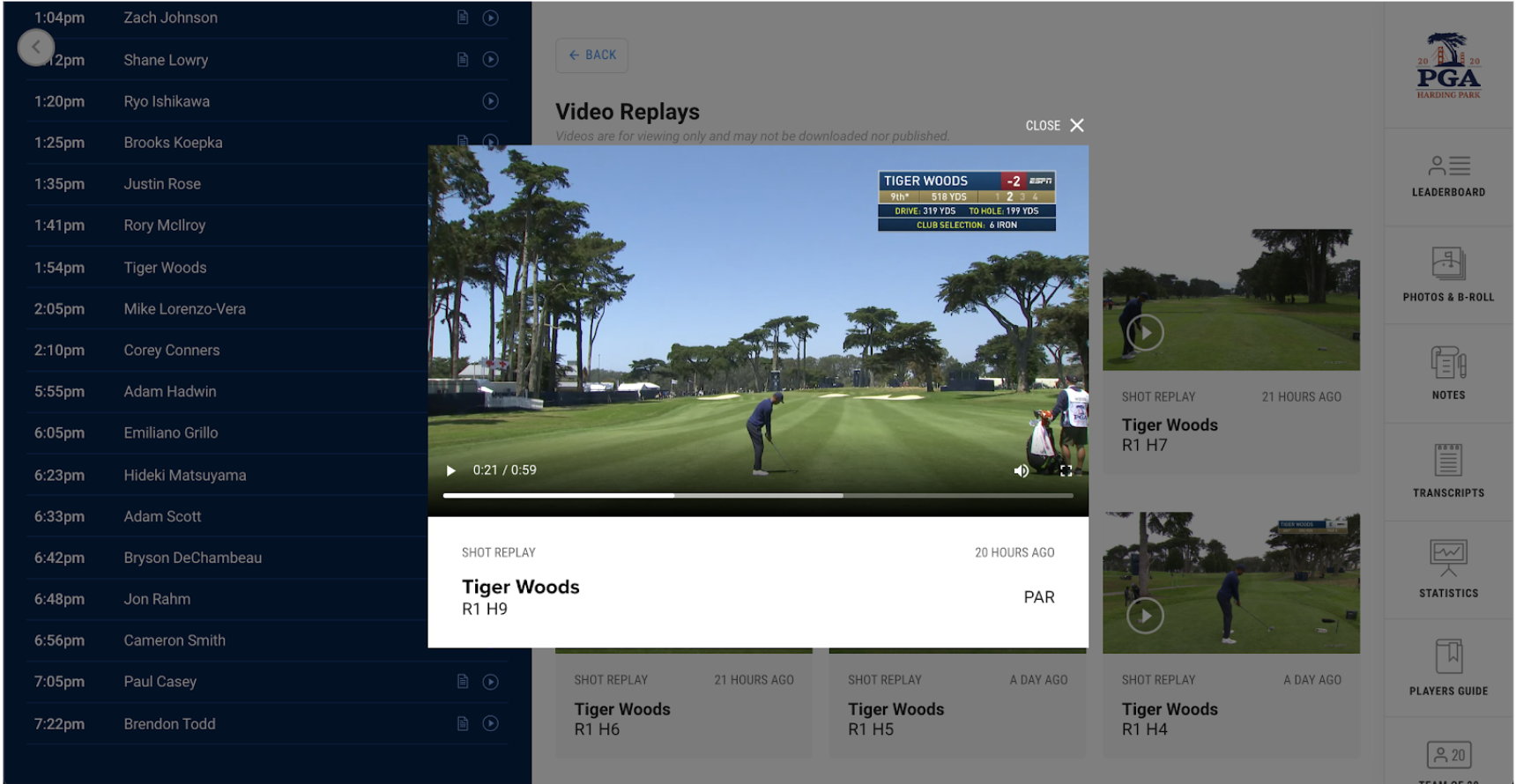
0:52:47 CC: How do you deliver that in a normal environment and why was it important to have that in the hub?
0:53:03 PK: The championship resources page was really a one-stop shop for anything that was available in advance of the championship. So anything like a media guide, a field list. Some of these things that happen over the course of the week, like a prize payout, more of these one-off items that media are very interested in having access to, it's not as critical, and they shouldn't have as much prominence as those real-time alerts or those real-time videos or the schedule. But it's a one-stop shop for some of these very important documents to reference as they're covering the championship, so it was nice to just have this place that if I needed a new document added, we could just throw it up there and kind of direct people that way.
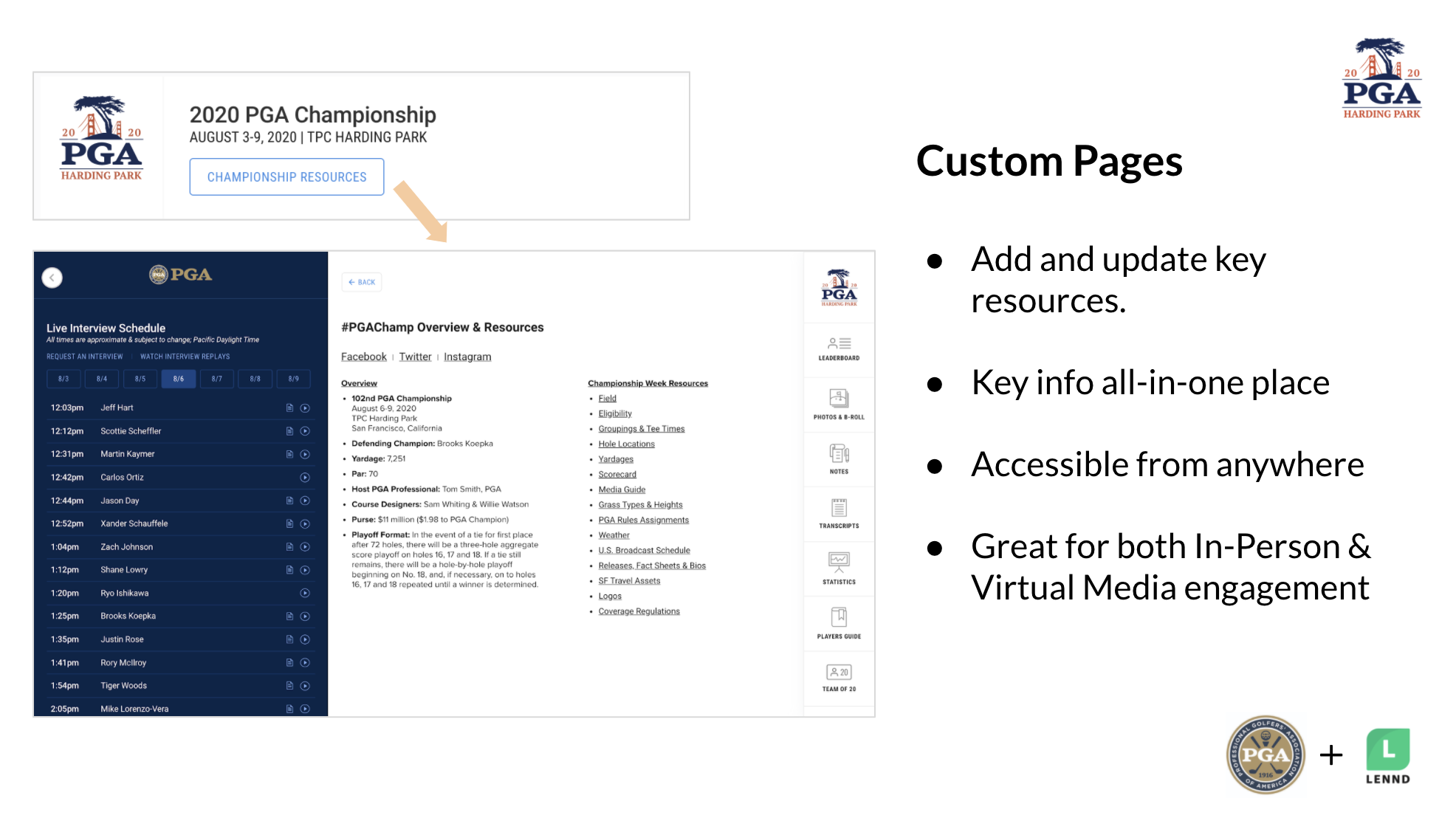
0:54:04 CC: Did you find that it was helpful at all for media that was on site?
0:54:21 PK: Significantly. Yeah, I think we probably underplayed that going into it. We were so focused on providing a tool to support remote coverage, I don't know if... I might just be speaking for myself, but I didn't necessarily realize how helpful it would be for those that were on site.
Like I said, we started seeing media calling in to press conferences from the media center through the media hub, rather than walking over, which is fine. The information that we were sharing through that news and alert section, it's not just for remote media, those that were on site used it as well, so it serves multiple purposes, it serves multiple groups, and I think that's why we're all so excited about how we can continue to enhance the experience both on-site and remote through the media hub.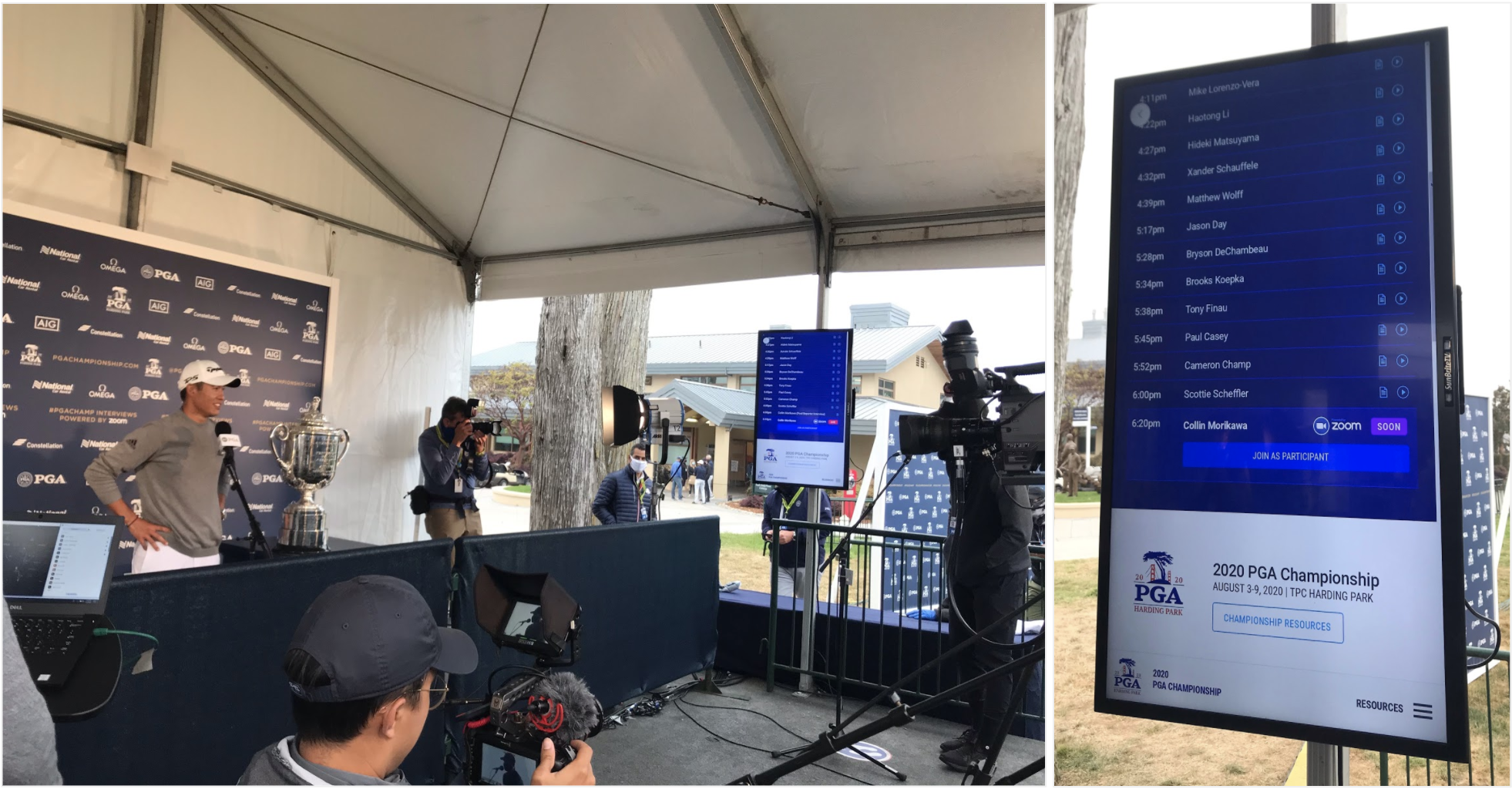
0:55:24 LE: Also, it was a great tool for staff and support, even on site, the event productions team, NMR, that helped us set up the whole press conference area, we set up a monitor that just loaded the schedule from the media hub, so they could keep an eye on the schedule and they could see, when was a lunch break? When could they fit in a lunch break or when would they need to be getting the microphones ready or turning on the camera. So they would be checking aspects of the media hub too, from a staff and planning perspective.
0:56:03 CC: What was the makeup of the ops team and partners on site?
0:56:18 PK: Yeah, so NMR was our AV crew. I wanna say they had maybe six people, six or seven people, a camera operator, someone managing the audio, there were two individuals, two or three individuals that were responsible for swapping out the microphones that players were using. Obviously given circumstances, we took as many precautions as possible to make sure it was a safe environment for players. So after a player was finished interviewing, finished with their press conference, we would swap out those microphones to make sure that they were safe to go.
In terms of our staff, Liz was supporting Zoom press conferences, basically a production coordinator on that side. John Dever was moderating every interview, I managed the schedule and Julius Mason, a Senior Director here at the PGA of America, was really tasked with making sure that we had players to bring over, so he was primarily the individual that would approach a player once they exited scoring. Thought we lost you, Liz.
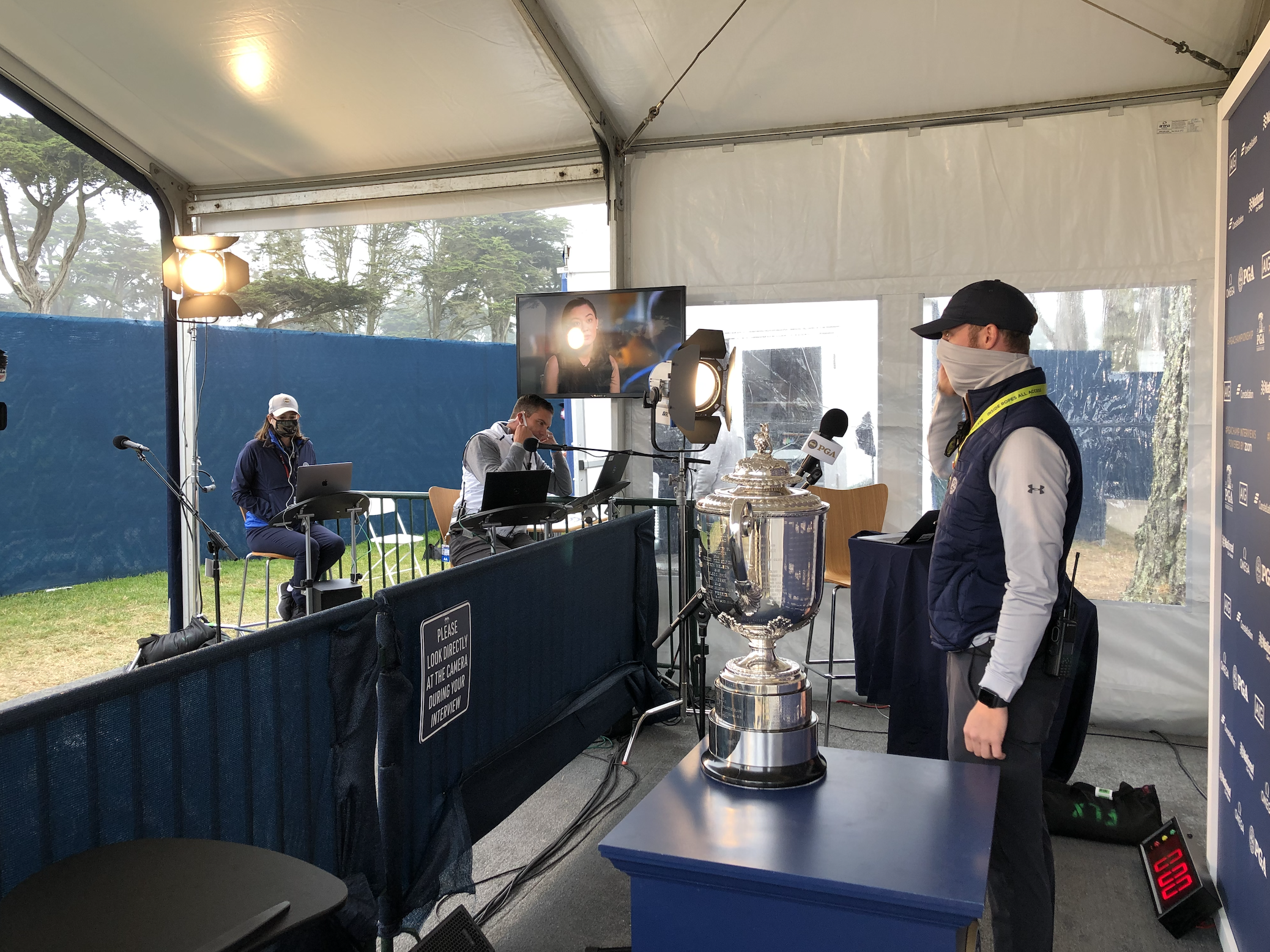
0:57:38 LE: [chuckle] I'm in a place where family's walking in and out, so...
0:57:41 PK: Got it.
0:57:41 LE: A little noise in the background.
0:57:43 CC: And how many days before the event did you get on site, did the team get on site?
0:57:52 PK: I got out there on Thursday before... I think most of the team showed up Sunday or so...
0:58:00 LE: Yeah, I was there on Saturday, flew in on Friday night.
0:58:04 CC: What did those few days look like from an operational perspective before things kicked off?
0:58:11 PK: For me, it was really just getting comfortable with the lay of the land and making sure that I knew where things were, that part of my advanced week preparation was the same as any other year. I'm not familiar with a lot of the sites that we go to. I'll typically make one stop there before, but once structures are put up, it's kind of learning a brand new site, so really getting comfortable with the site plan. And I think we had maybe two or three rehearsals on the Zoom side to make sure that we were set up for our first interviews on Tuesday.
0:58:50 LE: And for the technology side, we have a couple of vendors that we work with there who support infrastructure. So not only the event production team, NMR, but we have Safari who does network infrastructure and sets that all up. And then we have a couple of folks who are IT support that are on site. So we had some kickoff meetings with them, just kind of helped clarify and agree on roles and responsibilities, and then how to triage and address any issues that might come up that are outside of the media hub. They might be anywhere, they could be in the media center, they could be in the clubhouse, wherever an issue might come up that's technology-related, just making sure we had the right people in place to address issues.
0:59:33 CC: And so you guys get on site, what were you most nervous about at that point?
0:59:53 LE: Just obviously you personally don't want to get sick but you also don't want somebody in your family who's at home to get sick and then you have trouble getting back to them. So that was first and foremost.
1:00:04 CC: From a non-Coronavirus standpoint?
1:00:10 LE: Definitely like potentially any technology falling down. For us, we worry about the leaderboard and scoring, and we worry about network infrastructure like is WiFi going to go down for the people who are supporting the event? And then for the media hub, there's the added complexity of a the live Zoom call that's happening for however many 12 hours a day every day of the championship and getting people trained up on that, making sure everybody's comfortable using those tools, hoping that it feels seamless to the media folks who are watching and to the spectators who are watching ultimately.
1:00:55 PK: Liz hit it all but I would say I trusted all the partners that we were working with. I trusted the technology, so I wasn't as concerned. I think you're always worried about something falling down. But my biggest fear was that there wouldn't be enough buy-in from media, just because it's a brand new tool and we've never used it before. So they quickly squashed that fear, they used it immediately and enjoyed it. So yeah, I think there's no precedent for understanding a buy-in, predicting the buy-in I should say was certainly on my mind a lot.
.jpg?width=2241&name=PGAC_08_04_20_171_jpg_LargeImage_m192717%20(2).jpg)
1:01:39 CC: Was there one aha moment for you where you're like, "Oh, this is gonna be... This is awesome," or whatever it was, I don't know if that's how you felt about it but...
1:01:52 PK: There actually was for me and I think Liz you probably remember this. Tiger was our second interview of the week. Jon Rahm was right before him. So we had two really high profile players coming through to start off our whole media hub and live press conference experience. And both of them were on ESPN platforms. I think Jon Rahm was on ESPN plus and then Tiger's interviews on Sports Center. And I remember after Tiger's interview, I kind of looked over to my right to Liz and I was like, we both just had this kind of sigh relief of, "Okay, we're good, this is gonna be fine." So that was the aha moment for me for sure of just, we got through what was probably the biggest interview of the week on Tuesday. And we knew that we were in a good spot at that point.
1:02:49 CC: That's awesome. And same for you, Liz, or was there another moment?
1:02:54 LE: Definitely that moment, but also having a specific rep from the media walk over to me in the press area, and compliment the media hub. To me, I was very nervous just about adoption. And to have somebody actually take the time to walk over and express that they were really, really genuinely happy with the product. And even when I pressed them and said, "Hey, we love feedback, and we'd love to know if you think it could be better," and they said, "Oh, no, no, no, I love it. It's great." To me, that was a big one. Yeah.
1:03:31 CC: That's cool. Yeah, for me, I randomly... I was watching an interview with... Two separate interviews, one with your president and CEO. And they mentioned it and they were talking, they were actually playing it up. And I'm like, they wouldn't play it up if that wasn't... So that was one. And then another one was with one of the lead broadcasters that was talking about how helpful it was. And it was a pretty good moment from my standpoint.
Were there any informative stats and results that you guys look at and you're like, "That made it a success?"
1:04:16 PK: Yeah, the number we have thrown out internally a lot is 102 interviews, which was more than we've done the last three years. So to be able to pull that off in a year like this was certainly something we're proud of. We had 229 unique participants that called into Zoom over the course of the week. So 229 people that either participated in an interview or at least engaged. 99 alerts. And then I think the most telling stat is despite having less than 5% of the on-site media that we had a year ago at Bethpage Black in 2019, the overall media impressions were about the same.
1:05:05 CC: Wow.
1:05:06 PK: Which tells me that people were covering this championship from wherever they were, in a way that reached really everywhere. So that was obviously super encouraging.
1:05:19 CC: How do you think this impacts an event when you start to have fans again? You know, what's your take on that?
1:05:37 PK: Yeah, I think, we want to use this moving forward because it's a game changer, not just for media. It's also a game changer for our staff and for those that are invested in the media operation. Like we said, this is a tool that I think we didn't pay as close attention to how much of an impact it would have on site, but it did. And like Liz said there were folks that came up to her over the course of the week that acknowledged how much they enjoyed it and used it, so we know that there's value for on-site media, and it's really trying to best understand how we can continue to enhance it in a way that allows their experience to be incredible.
1:06:28 CC: What advice do you have for any organizations considering something like this? How would you approach it again? Would you do it any differently? When organizations do reach out, what are some of the things that you're helping them with?
1:06:54 PK: Yeah, we spoke with the UFC through an introduction by you Chris, and we spoke with them after the PGA Championship to talk through our experience, and it was kind of numbing to think about generally speaking, nobody would compare professional golf to the UFC. But the problems that we're solving are very similar if not the exact same on the media side. So it's a tool that really changed the way that we worked. It changed the way that we communicated with media, and it made it so much easier for everybody involved. So I think that's the one thing I would share with people is this is a communications tool at its core. It obviously has so many layers that are important, but if you're looking to improve your event communications with whoever your target group is, this is a tool that we certainly saw the value in, and we're excited about how it's gonna help us moving forward.
1:08:04 CC: That's awesome. Well, obviously as always, I really appreciate the time. It was such a great experience for us to get to work with you guys, and I'm excited to continue the relationship, but in general, I think part of what makes this overall success is how dialed in and buttoned up your teams were. The technology is important but I think as important is the operational expertise that you guys brought to the table. So it was really cool to see that from my end. So I think when you marry the two, and I do think that there's a lot of just inherent knowledge and expertise that hopefully this type of interview will be able to share with other folks who are going through it or about to go through it. So again, as always, I really appreciate you guys taking the time.
1:09:06 PK: Thank you for having us.
1:09:07 LE: Thank you so much. We so appreciate LENND and all the experience and knowledge you guys bring to the table, and all the contributions you guys made to the product that helped it be great and a success for us, so thank you.
1:09:25 CC: Cool. Of course. Of course. We'll talk to you guys soon.
-----
LENND, INC
Lennd is a next generation event technology platform that simplifies operations and planning so event teams can work smarter, move faster, and improve their ROI.
To learn why some of the most respected event teams trust Lennd to power their operations and learn more about our virtual event tools sign up for a demo: www.lennd.com.


